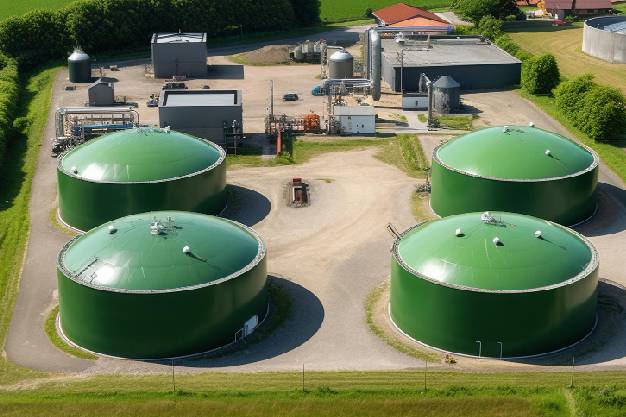
Renewable energy stands as our guide to a cleaner, greener future, countering the looming threat of climate change. ith rising temperatures and the Specter of extreme weather events, the demand for eco-friendly alternatives grows more pressing. In this critical context, biogas emerges as a superhero, quietly transforming our energy landscape by offering a robust alternative to fossil fuels. This article underscores the potential of converting agricultural lignocellulosic residues into Compressed Biogas (CBG). It also explores the wider landscape of green energy in India as the nation progresses towards carbon neutrality.
Biogas can be produced from a variety of organic waste sources, encompassing agricultural waste (including the burning of stubble by farmers, a significant contributor to winter pollution in the national capital), press mud, spent wash, condensate, municipal solid waste, and food waste. This potential presents new economic opportunities for farmers, waste management firms, and other stakeholders involved in biogas production.
The potential of biogas in green energy generation and Government of India initiatives.
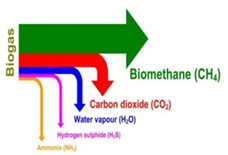 Leveraging biogas in India's waste-to-energy transition holds substantial potential for ensuring energy security, affordability, entrepreneurial opportunities, job creation, and stimulating local economies. This approach effectively addresses India's waste management challenges by implementing circular economy models. Govt of India has identified the potential of Biogas and during November 2022, The Ministry of New and Renewable Energy (MNRE), Government of India has notified the National Bioenergy Program. The primary goal of Swachh Bharat Mission (SBM-U 2.0) is to create garbage-free urban areas by emphasizing sustainable sanitation, efficient waste management, and promoting circular economy practices. The ambitious target is to establish 15,000 Tons Per Day (TPD) Bio-Compressed Biogas (CBG) plants by 2026. The Ministry of Housing and Urban Affairs (MoHUA) has directed States/Urban Local Bodies (ULBs) to support Oil and Gas Marketing Companies (OGMCs) in establishing CBG plants, aiding such as long-term concession agreements, land leases, and ensuring a continuous supply of segregated organic municipal waste.
Leveraging biogas in India's waste-to-energy transition holds substantial potential for ensuring energy security, affordability, entrepreneurial opportunities, job creation, and stimulating local economies. This approach effectively addresses India's waste management challenges by implementing circular economy models. Govt of India has identified the potential of Biogas and during November 2022, The Ministry of New and Renewable Energy (MNRE), Government of India has notified the National Bioenergy Program. The primary goal of Swachh Bharat Mission (SBM-U 2.0) is to create garbage-free urban areas by emphasizing sustainable sanitation, efficient waste management, and promoting circular economy practices. The ambitious target is to establish 15,000 Tons Per Day (TPD) Bio-Compressed Biogas (CBG) plants by 2026. The Ministry of Housing and Urban Affairs (MoHUA) has directed States/Urban Local Bodies (ULBs) to support Oil and Gas Marketing Companies (OGMCs) in establishing CBG plants, aiding such as long-term concession agreements, land leases, and ensuring a continuous supply of segregated organic municipal waste.
In Nov 2023 the government has mandated the phased blending of compressed biogas (CBG) into compressed natural gas (CNG) and piped natural gas (PNG) from the fiscal year 2025-26, targeting 5% blending by 2028-29. Blending percentages are set at 1% in 2025-26, increasing to 3% and 4% in the following two years. Until 2024-25, blending remains voluntary. The move aims to stimulate CBG demand, reduce liquefied natural gas imports, save forex, promote a circular economy, and contribute to net-zero emissions. CNG, a cleaner fuel than petrol and diesel, constitutes nearly 14% of total passenger vehicle sales in India. Biogas, mainly methane and carbon dioxide, can replace natural gas after purification.
Achieving the targeted 5% blending of biogas with natural gas not only has the potential to reduce LNG imports by $1.17 billion but can also result in a 2% decrease in per capita CO2 emissions, benchmarked against the 2019 figure of 1.9 metric tonnes of CO2 per person in India. Moreover, diverting organic waste from landfills is highlighted as a measure with numerous benefits. The mandatory CNG blending initiative is expected to attract investments of around Rs 37,500 crore and pave the way for the establishment of at least 750 compressed biogas (CBG) projects by 2028–29, according to government estimates.
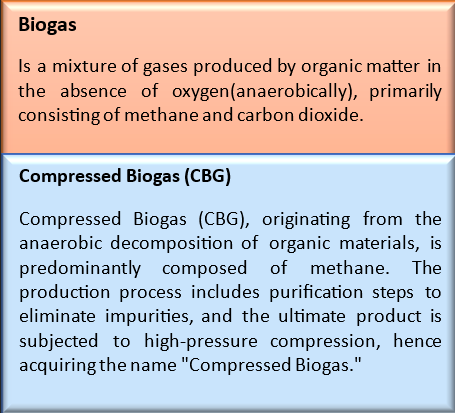
 Amenable feed stock for biogas production
Biodegradable feedstocks, in various physical states, encompass agricultural wastes, crop residues, industrial by-products, animal wastes, aquatic waste, forest residues, and municipal solid wastes, all utilized for biogas production. Agricultural sources include animal manures, vegetable by-products, and energy crops. Industrial origins involve organic wastes from agroindustry, food industries, fodder, brewery & distillery industries, as well as by-products from biofuel production and biorefineries. Municipal sources consist of source-separated household waste, sewage sludge, municipal solid waste, and food residues. Aquatic biomass includes microorganisms (planktonic), macroalgae, and fish.
Amenable feed stock for biogas production
Biodegradable feedstocks, in various physical states, encompass agricultural wastes, crop residues, industrial by-products, animal wastes, aquatic waste, forest residues, and municipal solid wastes, all utilized for biogas production. Agricultural sources include animal manures, vegetable by-products, and energy crops. Industrial origins involve organic wastes from agroindustry, food industries, fodder, brewery & distillery industries, as well as by-products from biofuel production and biorefineries. Municipal sources consist of source-separated household waste, sewage sludge, municipal solid waste, and food residues. Aquatic biomass includes microorganisms (planktonic), macroalgae, and fish.
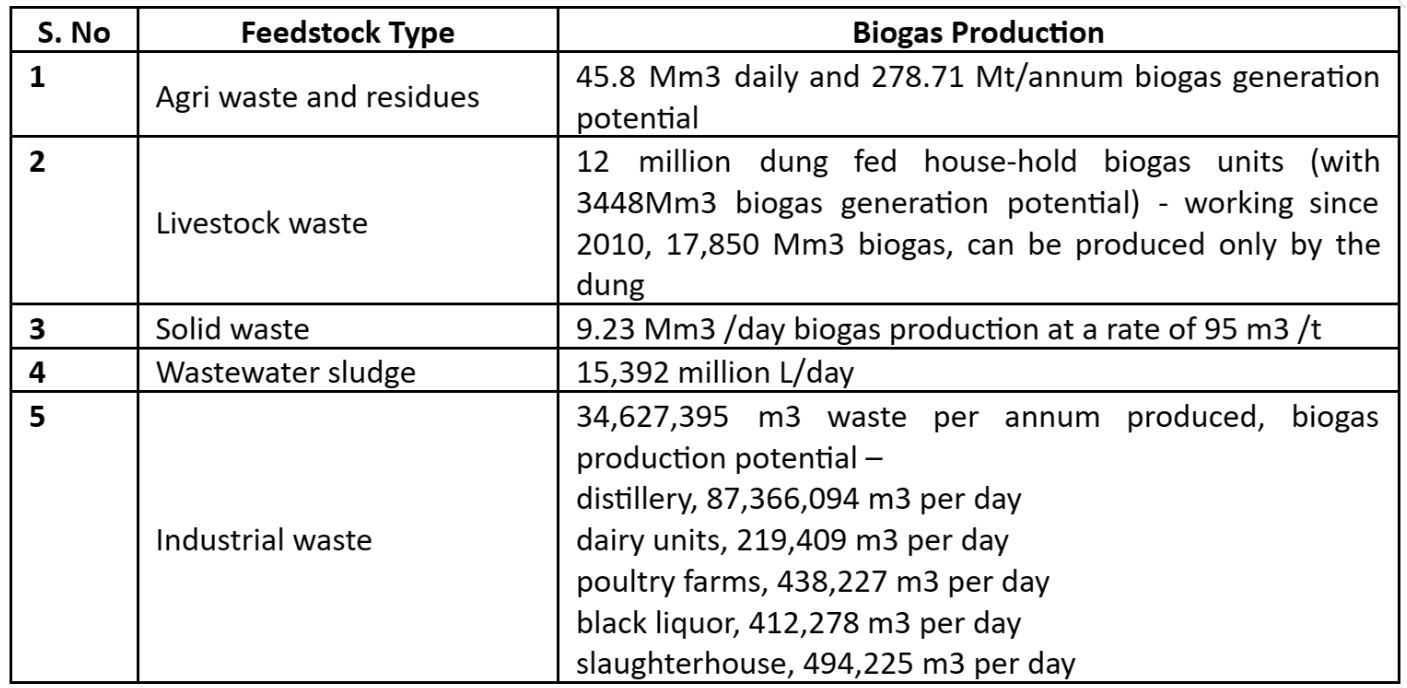
Feedstock from Sugar & distillery Industries
The unsung hero of Biogas – Press mud
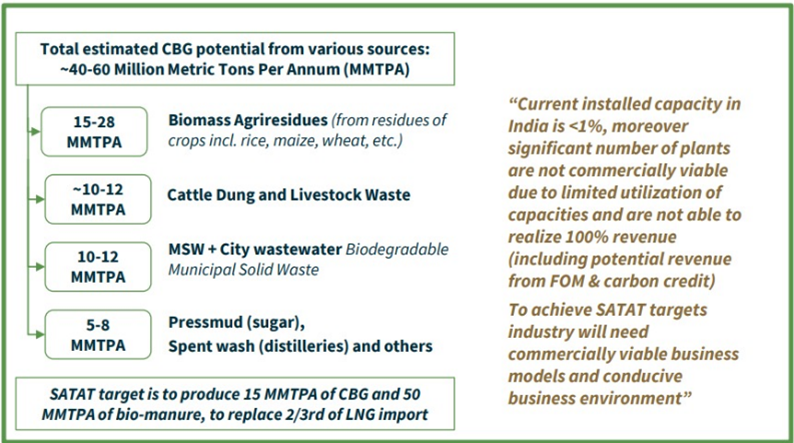 Press mud, a sugar industry byproduct known as filter-cake, holds untapped potential for biogas production. Often dismissed as waste, it contains methane, a crucial element for biogas. Instead of being used as organic fertilizer or traded for sugar cane, forward-thinking sugar mills are leveraging Press mud for biogas, offering environmental benefits and economic gains. Biogas production, using anaerobic digesters, transforms Press mud and spent wash into raw biogas. Scrubber refinement yields Bio CNG, a sustainable alternative to traditional LPG and CNG. The residual matter becomes potent organic manure, completing a sustainable cycle. Press mud’s methane-rich composition makes it suitable for anaerobic digestion, generating Compressed Biogas (CBG)—a renewable, eco-friendly gaseous fuel. This shift from waste to energy underscores Press mud’s role as a valuable resource in sustainable energy endeavours.
Press mud, a sugar industry byproduct known as filter-cake, holds untapped potential for biogas production. Often dismissed as waste, it contains methane, a crucial element for biogas. Instead of being used as organic fertilizer or traded for sugar cane, forward-thinking sugar mills are leveraging Press mud for biogas, offering environmental benefits and economic gains. Biogas production, using anaerobic digesters, transforms Press mud and spent wash into raw biogas. Scrubber refinement yields Bio CNG, a sustainable alternative to traditional LPG and CNG. The residual matter becomes potent organic manure, completing a sustainable cycle. Press mud’s methane-rich composition makes it suitable for anaerobic digestion, generating Compressed Biogas (CBG)—a renewable, eco-friendly gaseous fuel. This shift from waste to energy underscores Press mud’s role as a valuable resource in sustainable energy endeavours.
In 2022-23, India's 531 operational sugar mills comprised 330 private, 190 cooperative, and 11 public mills achieved a sugar production of 32.74 million tons, accompanied by around 11.4 million tons of Press mud. This quantity of press mud holds the potential to generate 460,000 tons of Compressed Biogas (CBG), valued at Rs 2,484 crore, considering the minimum guaranteed price of Rs 54/kg under the central government's SATAT scheme.
The Distillery Dilemma - Navigating Spent wash Challenges with Biogas Innovation
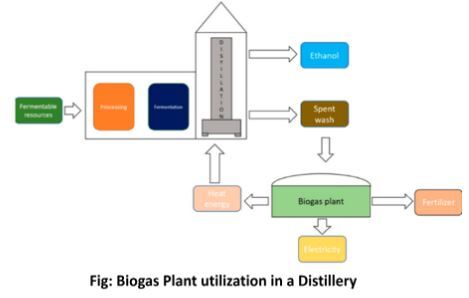
Traditionally, biogas generated from spent wash served the purpose of hydrogen sulphide (H2S) removal, typically burned directly in boilers. Recent investigations have uncovered a more cost-effective alternative: Bio-CNG. By substituting traditional fossil fuels, Bio-CNG not only aligns with economic efficiency but also signifies a pivotal moment in the distillery sector's journey toward sustainability. The availability of spent wash for 240-270 days, compared to press mud for 180 days in a year, adds an advantage as a feedstock.
Challenges in biogas production Storage of feedstock
Feedstock such as press mud is accessible solely during the sugar production season and requires storage for an extended duration to facilitate year-round biogas production during the off-season. The primary objective should be to preserve the volatile solids intact while storing press mud, a task made challenging by its susceptibility to rapid microbial degradation. This poses difficulties in both storage and utilization. The complexities of storage, attributed to the gradual decomposition, call for innovative solutions to mitigate methane emissions.
Pretreatment of complex feedstock
The composition and intricate nature of diverse feedstocks approved for biogas production pose a significant challenge in the overall anaerobic digestion process. These feedstocks predominantly consist of lignocellulosic materials, comprising cellulose, hemicellulose, and lignin, intricately interconnected in a complex structure. Cellulose, characterized by its high crystallinity, poses challenges in depolymerization due to its rigidity and insolubility in water. Modifying the cellulose structure is both difficult and essential for efficient utilization. Adequate pretreatment methods play a crucial role in disrupting cellulose bonding, thereby enhancing its degradability. Without proper pretreatment, the crystalline nature of cellulose adversely affects the hydrolysis rate, consequently impacting biogas production.
Nutrition to handle microbial growth
The fluctuations in feedstock composition leads to elevated Chemical Oxygen Demand (COD) levels, increased temperature, and heightened acidity. Operating the anaerobic digester becomes challenging due to reduced bacterial growth and COD removal rates resulting from these variations. Over time, this leads to suboptimal performance of the anaerobic tanks. Additionally, methane-generating archaea and other anaerobic organisms are sensitive to adverse conditions such as low pH, high volatile acids, and variable loading rates. Addressing these challenges requires the supplementation of micronutrients, cofactors, and enzymes to provide essential building blocks for the growth and stabilization of anaerobic bacteria.
Holistic Solution by The Catalysts Group
In this dynamic landscape, The Catalysts Group has positioned itself as a trailblazer by providing state-of-the-art products and solutions. Focused on 'Grain to Ethanol' fermentation, the group has been a leader in the Compressed Biogas (CBG) revolution. The offerings from The Catalysts Group encompass:
i. Innovative Storage Solutions: Prolonged storage of feedstock can significantly influence its properties, potentially affecting biogas production. The Catalysts Group tackles storage challenges by employing cutting-edge technologies that extend the shelf life of Press mud. This approach guarantees a consistent and reliable supply for biogas production, contributing to the overall efficiency of the process.
ii. Advanced feedstock treatment solutions: Elevating methane yield and optimizing the anaerobic digestion process necessitate strategies for enhancing feedstock quality. The Catalysts Group excels in innovative feedstock improvement techniques, including enzymatic pretreatment and co-digestion. These approaches involve breaking down complex biomolecules into simpler forms, ensuring more efficient utilization of organic materials in anaerobic digestion. As a trailblazer in enzyme-based biotechnological solutions, The Catalysts Group offers a diverse range of enzyme formulations tailored for the treatment of a wide variety of feedstocks.
iii. Augmenting Biogas Production: Nutrition plays a pivotal role in the anaerobic digestion process, and The Catalysts Group excels in providing cutting-edge enzymes, micronutrients, and cofactors. These components serve as essential building blocks necessary for the growth and stabilization of anaerobic bacteria within anaerobic digesters, thereby enhancing the overall biogas production process.
iv. Collaborative Industry Engagement: Through strategic partnerships with global leaders, The Catalysts Group introduces top-tier practices and technologies to Indian industries, fostering the advancement of the Compressed Biogas (CBG) sector.
Conclusion:
In the expansive realm of sustainable initiatives, the Biogas vertical is gaining prominence as an environmentally friendly industry, buoyed by the Biogas blending policy. In the context of sugar and ethanol sectors, press mud and spent wash serve as pivotal elements, contributing significantly. The transformation of these byproducts into biogas, particularly in the Bio-CNG form, not only brings economic benefits but also signifies a transformative shift towards a future where industries harmonize seamlessly with the natural environment.
Recent Posts
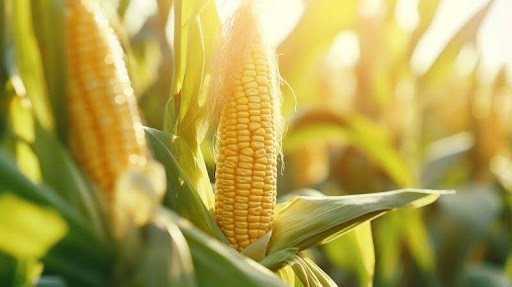
The Role of Enzymes in Maize-to-Ethanol Fermentation
With the rising demand for renewable energy sources and sustainable fuel alternatives, ethanol production has gained significant momentum worldwide. Ethanol, also known as bioethanol, is a biofuel commonly used as a renewable alternative to fossil fuels. One of the most popular feedstocks for ethanol production is maize (corn), primarily due to its high starch content, wide availability, and suitability for large-scale production.
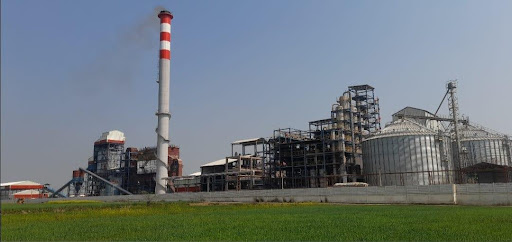
Challenges in Rice to Ethanol Fermentation and How to Overcome Them
Rice is one of the most important staple crops globally, particularly in Asia, where it constitutes a significant portion of daily food intake. However, rice also has tremendous potential as a feedstock for ethanol production due to its high starch content.

Uses of Enzymes in Grain to Ethanol Fermentation: A Comprehensive Guide
Ethanol production through the fermentation of various feedstocks has gained considerable attention as a renewable energy source. Among the many feedstocks, grains such as corn, wheat, rice, barley, and sorghum play a crucial role due to their high starch content, which can be effectively converted into ethanol.
Catalysts Connect
Keep up to date with our latest news and analysis by subscribing to our regular magazine and newsletter

-1708929740.JPG)
Post a comment
Your email address will not be published.